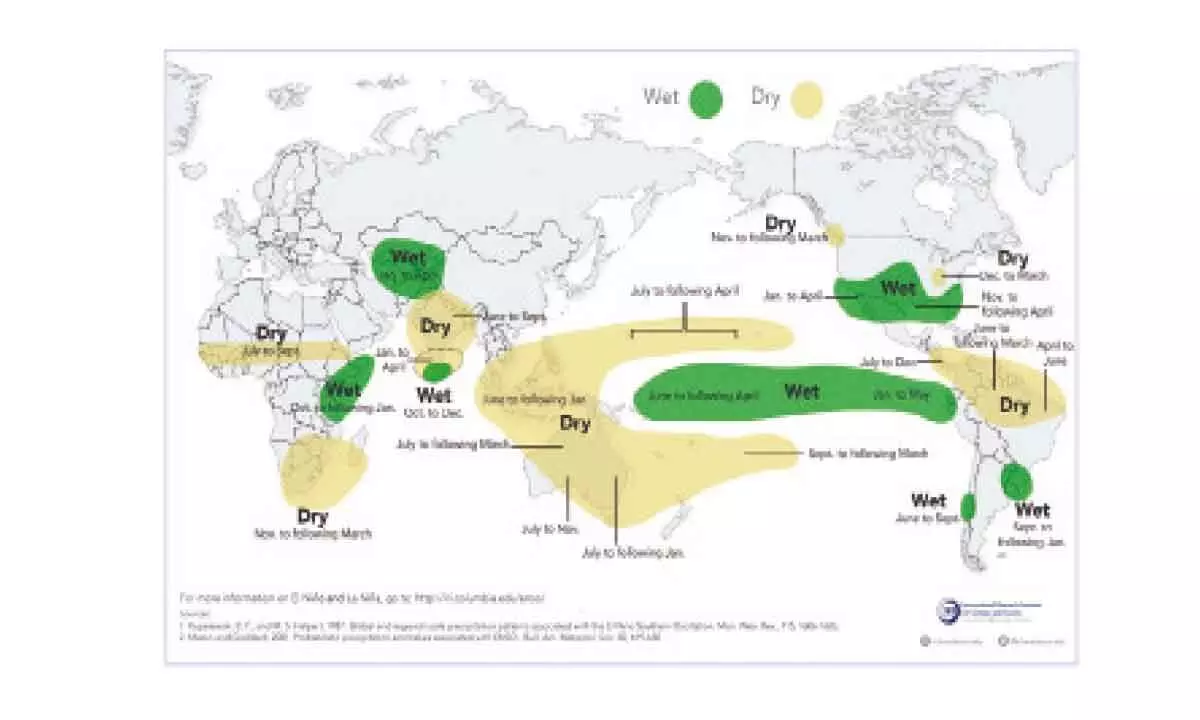Likelihood of El Nino later this year

Geneva: The likelihood of El Nino developing later this year is increasing, a new update from the World Meteorological Organization (WMO) said on Wednesday.
This would have the opposite impacts on weather and climate patterns in many regions of the world to the long-running La Nina and would likely fuel higher global temperatures.
The unusually stubborn La Nina has now ended after a three-year run and the tropical Pacific is currently in an ENSO-neutral state (neither El Nino nor La Nina).
There is a 60 per cent chance for a transition from ENSO-neutral to El Nino during May-July 2023, and this will increase to about 70 per cent in June-August and 80 per cent between July and September, according to the update, which is based on input from WMO Global Producing Centres of Long-Range Forecasts and expert assessment.
At this stage there is no indication of the strength or duration of El Nino.
“We just had the eight warmest years on record, even though we had a cooling La Nina for the past three years and this acted as a temporary brake on global temperature increase. The development of an El Nino will most likely lead to a new spike in global heating and increase the chance of breaking temperature records,” said WMO Secretary-General Prof. Petteri Taalas.
According to WMO’s State of the Global Climate reports, 2016 is the warmest year on record because of the “double whammy” of a very powerful El NiAo event and human-induced warming from greenhouse gases. The effect on global temperatures usually plays out in the year after its development and so will likely be most apparent in 2024.
“The world should prepare for the development of El NiAo, which is often associated with increased heat, drought or rainfall in different parts of the world. It might bring respite from the drought in the Horn of Africa and other La Nina-related impacts but could also trigger more extreme weather and climate events. This highlights the need for the UN Early Warnings for All initiative to keep people safe,” said Prof Taalas.
No two El Nino events are the same and the effects depend partly on the time of year. WMO and National Meteorological Hydrological Services will therefore be closely monitoring developments.
El Nino is a naturally occurring climate pattern associated with warming of the ocean surface temperatures in the central and eastern tropical Pacific Ocean. It occurs on average every two to seven years, and episodes usually last nine to 12 months.
El Nino events are typically associated with increased rainfall in parts of southern South America, the southern US, the Horn of Africa and central Asia.
In contrast, El Nino can also cause severe droughts over Australia, Indonesia, and parts of southern Asia.
During the Boreal summer, El Nino’s warm water can fuel hurricanes in the central/eastern Pacific Ocean, while it hinders hurricane formation in the Atlantic Basin.
Climate models have predicted that El Nino is on the horizon, which can lead to severe heat waves and droughts, in many countries, including India. El Nino is associated with a band of warm ocean water that develops in the central and east-central equatorial Pacific, including the area off the Pacific coast of South America. During El Nino, winds blowing west along the equator slow down, and warm water is pushed east, creating warmer surface ocean temperatures.
Last month, the World Meteorological Organisation (WMO) warned of a likely spike in temperatures globally this year, due to the warming El Nino event. El Nino will mean extreme weather around the globe and making it “very likely” the world will exceed 1.5 degrees Celsius of warming. The hottest year in recorded history, 2016, was driven by a major El Nino. The Indian Meteorological Department (IMD) has also predicted a 70 per cent chance of El Nino in India. While the agency has predicted a normal monsoon, it said El Nino can affect the monsoon. The impact of El Nino may be felt during the second half of monsoon season.








